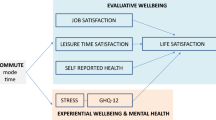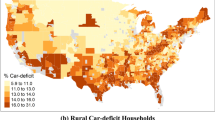Abstract
This paper introduces the concept of Primary Family Priority Time (PFPT), which represents a high priority household decision to spend time together for in-home activities. PFPT is incorporated into a fully specified and operational activity based discrete choice model system for Copenhagen, called COMPAS, using the DaySim software platform. Structural tests and estimation results identify two important findings. First, PFPT has a place high in the model hierarchy, and second, strong interactions exist between PFPT and the other day level activity components of the model system. Forecasts are generated for a road pricing and congestion scenario by COMPAS and a comparison version of the model system that excludes PFPT. COMPAS with PFPT exhibits less mode changing and time-of-day shifting in response to pricing and congestion than the comparison version.



Similar content being viewed by others
References
Aalborg University (2012) ACTUM WP2: P0/P1 Analysis Report - making daily mobility
Arentze, T.A., Timmermans, H.J.P.: A learning-based transportation oriented simulation system. Transp. Res. B 38(7), 613–633 (2004)
Bonke, J. (2002) Forældres brug af tid of penge på deres børn. Report from Rockwool fondens forskningsenhed, Denmark
Bonke, J. (2009) Tid og velfærd. Report from Socialforskningsinstitut, Denmark
Bowman, J.L.: The day activity schedule approach to travel demand analysis. Ph.D. dissertation, Massachusetts Institute of Technology, Cambridge, Massachusetts, USA (1998). Available at www.JBowman.net
Bradley, M., Bowman, J.L.: A summary of design features of activity-based microsimulation models for U.S. MPOs. White paper presented at the TRB Conference on Innovations in Travel Demand Modelling, Austin, USA May 2006. Available at www.JBowman.net
Bradley, M., Bowman, J.L., Griesenbeck, B.: SACSIM: An applied activity-based model system with fine-level spatial and temporal resolution. J. Choice Model. 3(1), 5–31 (2010)
Bradley, M., Vovsha, P.: A model for joint choice of daily activity pattern types of household members. Transportation 32, 545–571 (2005)
Chapin, F.S.: Human activity patterns in the city: Things people do in time and space. Wiley, New York (1974)
Commission of Work-Life Balance (Familie of Arbejdslivskommissionen) (2007) Chance for balance—etfællesansvar. Report of the Danish Government
DTU Transport (2012) TU data. Available at http://www.modelcenter.transport.dtu.dk/Transportvaneundersoegelsen/TU-udgivelser/TU-rapport-om-danskernes-transportvaner-2012
Gupta, S., Vovsha, P.: A model for work activity schedules with synchronization for multiple-worker households. Transportation 40, 827–845 (2013)
Hagerstrand, T.: What about people in regional science? Reg. Sci. Assoc. Pap. 24, 7–21 (1970)
Ho, C., Mulley, C.: Tour-based mode choice of joint household travel patterns on weekend and weekday. Transportation 40, 789–811 (2013)
Jones, P.M., Dix, M.C., Clarke, M.I., Heggie, I.G.: Understanding travel behaviour. Gower, Aldershot (1983)
Kitamura, R., Fujii, S.: two computational process models of activity-travel behavior. In: Garling, T., Laitila, T., Westin, K. (eds.) Theoretical Foundations of Travel Choice Modeling, pp. 251–279. Elsevier, Amsterdam (1997)
Konduri, K.C., Xin, Y., Pendyala, R.: Probit-based discrete-continuous model of activity choice and duration with history dependency. Transp. Res. Rec. 2156, 17–27 (2010)
Meloni, I., Bez, M., Spissu, E.: Activity-based model of women’s activity-travel patterns. Transp Res Rec 2125, 26–35 (2009)
Pas, E.I.: The effect of selected sociodemographic characteristics on daily travel-activity behavior. Environ. Plan. A 16, 571–581 (1984)
Srinivasan S., Bhat, C.: A multiple discrete-continuous model for independent and joint-discretionary-activity participation decisions. Transportation 33, 497–515 (2006)
Vovsha, P., Freedman, J., Livshits, V., Sun, W.: Design features of activity-based models in practice: Coordinated travel-regional activity modeling platform. Transp. Res. Rec. 2254, 19–27 (2011)
Vovsha, P., Petersen, E., Donnelly, R.: Model for allocation of maintenance activities to household members. Transp. Res. Rec. 1894, 170–179 (2004a)
Vovsha, P., Petersen, E., Donnelly, R.: Impact of intra-household interactions on individual daily activity-travel patterns. Transp. Res. Rec. 1898, 87–97 (2004b)
Acknowledgments
The work represented in this paper was funded by the Danish Research Council as part of the ACTUM project. The authors gratefully acknowledge the suggestions of anonymous reviewers of earlier drafts.
Author information
Authors and Affiliations
Corresponding author
Appendix: AB model system context
Appendix: AB model system context
Overview
The household travel demand portion of the COMPAS model system consists of an integrated set of discrete choice models implemented on the DaySim software platform, an evolving and adaptable platform used for the development and application of practical AB microsimulation models (Bradley et al. 2010).
As depicted on the left in Fig. 1, the household models consist of long-term choice models, models at the day level that identify the tours and stop purposes for the day, and tour and trip models that model the details of each tour. The day level models constrain and condition the tour models, and are also impacted by accessibility arising from them. Also, in the course of the simulation, when a model at the day or tour & trip level determines that an activity or travel spans a particular period of time, that period becomes unavailable for other activities and travel.
Long term models
The COMPAS model includes three sub-models for long term decisions: usual work location, car ownership and public transport pass ownership. Eventually, it will also model school location, which is presently pre-determined when the synthetic population is generated.
Day level models
The day level models consist of numerous models in five main groups that operate in conditional sequence, according to a priority hierarchy, as shown in Fig. 1 on the right. The household day pattern type model determines the highest priority aspects of the day from the perspective of the household, namely a pattern type for each person, determined simultaneously for all members. For each person, the pattern type identifies whether they travel for work, school or business (mandatory type), travel only for other purposes (non-mandatory type), or stay home all day (at-home type).
PFPT participation is inserted into the hierarchy as a household choice immediately above the household day pattern type, modelled jointly with the household’s choice of whether to conduct one or more joint tours for non-mandatory purposes. Also, given that PFPT participation occurs, a PFPT schedule model determines the start time and duration of the PFPT activity.
Given the household’s day pattern type, including PFPT, the next group of models determines the specific mandatory activities for each person in the household, including the participation in in-home work activity for each worker, the number of work, business and/or school tours for each person with a mandatory pattern type, and whether they have any intermediate stops for work or school in their day.
Given the needs within the household for travel to work and school, the next set of models determines joint travel to and/or from those mandatory activities. Joint travel to work and school is only modelled for persons travelling to their usual work or school location. It can take the form of half tours, either to (Half Tour 1) or from (Half Tour 2) work and/or school. These half tours can be either paired or unpaired, where paired half tours are symmetrical, involving the same participants traveling together in both directions. They can also be either partially joint, in which one person drops off one or more others on their way to work or school, or fully joint, in which the destination for all participants is the same place. In fully joint half tours it is possible that one participant serves as a chauffeur and returns home after dropping off the other(s). The following examples illustrate the half tour definitions. In example 1, the household includes 2 workers (A, B) and two school children (C, D). In the morning, worker A drops both children C & D. In the afternoon, worker B picks-up child C, while child D returns home on her own. This household’s day includes two unpaired partially joint half tours; Half Tour 1 with A, C and D, and Half Tour 2 with B and C. In example 2, the children (C & D) travel to and from the same school together, while the parents go to and from work separately. In this case the household’s day involves two paired fully joint half tours conducted jointly by C and D.
To model joint half tours, a generation model determines for the household whether a joint half tour occurs and what type it is. This is followed by a participation model that determines, simultaneously for all eligible household members, which ones participate. This pair of models is repeated until the generation model determines that no more joint half tours occur.
Once the joint travel for mandatory activities has been determined, the next set of models determines the number of joint tours for non-mandatory purposes conducted by members of the household, and the purpose of each one. This is modelled via a tour generation model followed by a participation model, repeating until the generation model determines that there are no more joint tours to be conducted.
The last of the day level models is the person day activity pattern. Constrained by all the prior model outcomes, this pair of models determines, for each person, the number of tours in the day, the purpose of each tour, and the purposes for which intermediate stops are to be made, if any. First, the pattern model determines the presence of tour and stop purposes. Second, the generation model determines the number of tours for each purpose that the pattern model determined to be present. The number of intermediate stops for each purpose is left to be determined subsequently as the tours determined here are being simulated.
Tours and trips
COMPAS simulates the details of each household’s tours in the following priority order:
-
1.
Household’s partially joint half tours
-
2.
Household’s fully joint half tours
-
3.
Aspects of each person’s mandatory tours that have not been determined by joint half tour simulation
-
4.
Household’s joint non-mandatory tours
-
5.
Each person’s remaining non-mandatory tours
As each tour and trip is simulated, the outcomes are recorded for each participant, including the updating of their available time windows, so that subsequent models are properly constrained. For partially joint half tours, the pickup and/or drop-off sequence is determined, the tour mode is modelled, and the timing of all work and school arrivals and departures is modelled. For fully joint half tours, the tour mode and timing are modelled, and intermediate stops are generated—and the location, mode and timing of each stop are modelled—iteratively for both half tours. For person mandatory tours, the destination is modelled if it is a business tour, work-based sub-tours are generated, the tour mode and timing are modelled, and intermediate stops are generated and modelled as described above. For the household’s joint non-mandatory tours and each person’s remaining non-mandatory tours, the destination is modelled, and intermediate stops are generated and modelled, as described above.
Rights and permissions
About this article
Cite this article
Vuk, G., Bowman, J.L., Daly, A. et al. Impact of family in-home quality time on person travel demand. Transportation 43, 705–724 (2016). https://doi.org/10.1007/s11116-015-9613-2
Published:
Issue Date:
DOI: https://doi.org/10.1007/s11116-015-9613-2




